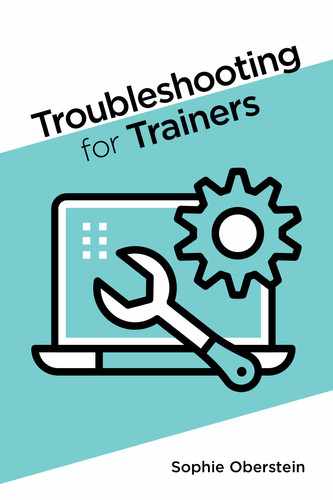Your Fix-It Guide to Training When you need to repair an appliance on the fritz, you can consult the instruction manual. But if you’re stuck when designing or facilitating training, what resource can you turn to for solutions to your problem? Part troubleshooting guide, part introduction to training design and delivery, Troubleshooting for Trainers delivers in-the-moment fixes and longer-term solutions for common challenges at every stage of the learning and development process. Pull it out when you’re in a predicament, flip to the related challenge listed in the table of contents, and find some immediate relief. Better yet, use it to discover tips and strategies that will help you proactively avoid the crises new trainers face. Covering more than 40 challenges, the book offers solutions for when: Perfect for the busy trainer, each chapter briefly describes a challenge for trainers, offers a series of solutions for overcoming it, and includes some resources to go deeper about the topic. Job aids and sample worksheets accompany the solutions. “If only I knew this when I was starting out.” Experienced trainers often express this sentiment later in their careers. Why wait? The next time you’re at a training impasse, troubleshoot your way out.
Table of Contents
- Cover
- Title Page
- Copyright
- Contents
- Introduction
- Section 1—Lack of Credibility
- Section 2—Training Isn’t Well Regarded
- Section 3—Lack Of Resources
- Section 4—Limited Learning Design Experience
- 15. I’ve Been Asked to Provide Training, But I Don’t Think It’s Going To Help
- 16. I’ve Been Asked to Create Training on a Topic I Know Nothing About
- 17. I Don’t Have an Instructional Design Background
- 18. I Want to Design Interactive Sessions, But I’m Not That Creative
- 19. I Want My Materials to Look Good—and Be Effective
- 20. I’ve Been Asked to Convert Training From Classroom to E-Learning and I Don’t Know Where to Begin
- 21. I Don’t Know How to Produce Asynchronous E-Learning
- 22. I’m Not Sure My Training Is “Sticky”
- 23. I’m Not Sure How to Design Informal Learning
- 24. My Learners Are Overwhelmed With Digital Information
- Section 5—Uncertainty Around Measurement
- Section 6—Live Training Surprises
- 29. I’m Nervous
- 30. The Technology Isn’t Working
- 31. The Training Room Isn’t Right
- 32. They’re Not Hooked From the Start
- 33. Participants Aren’t Taking Risks
- 34. Participants Seem Confused
- 35. I Don’t Know How to Respond to Their Questions
- 36. I’m Always Rushing at the End of My Sessions
- 37. I’m Not Ending on a Strong Note
- Section 7—Challenging Participants
- 38. Someone Is Monopolizing the Session
- 39. Someone Is Complaining Out Loud About Every Aspect of the Session
- 40. Someone Is Challenging Everything I Say
- 41. An Individual, or Entire Group, Keeps Going off on Tangents
- 42. A Few People Aren’t Saying Anything at All
- 43. There Are Varied Skill Sets and Expectations Among Participants
- 44. My Participants Are Distracted and Multitasking
- 45. People Keep Showing Up Late
- Conclusion
- References
- Index
- About the Author
- Back Cover
